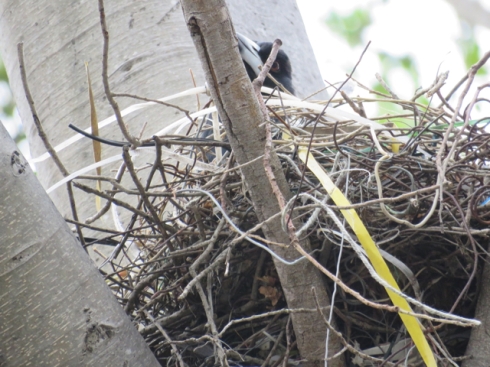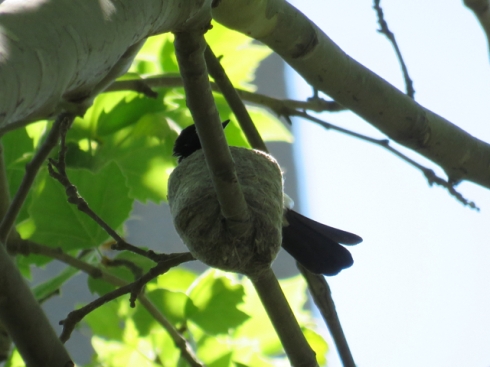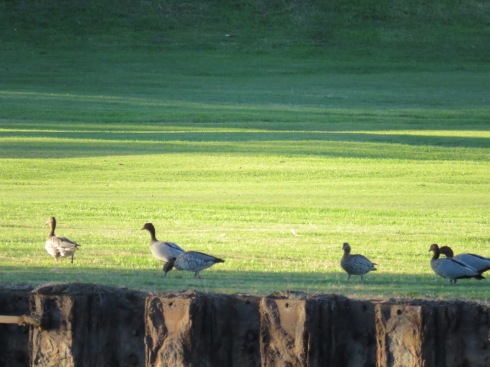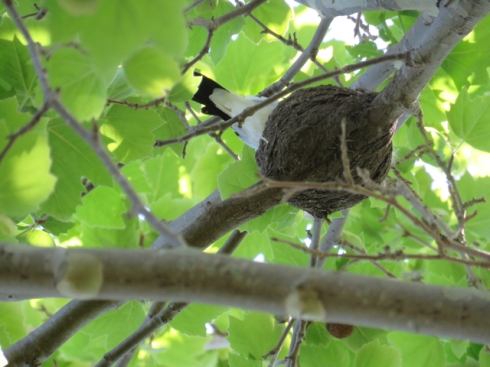You are currently browsing the tag archive for the ‘birds’ tag.

I have not been able to get down to the Cooks River for quite a while, until yesterday when I was lucky to spot this Nankeen night heron just outside his usual territory. If I am correct about this being the same bird, he is a voracious eater. I have sat watching him scoop up small fish with his beak and down them in one swallow only to do this again and again. I moved on after watching about 30 fish get swallowed and no sign of letting up. We are so lucky to have these birds living on the river.
Merry Christmas – Happy Holidays. I hope you are having a lovely day today whatever you are doing. I will be back to posting soon, hopefully before the new year. Thanks for your patience. Jacqueline 🙂
I ride up & down the Cooks River often & I am always on the lookout for birds. So, it was with great delight that I watched what I thought was a darter doing a magnificent display in the middle of the river.
It appeared to be washing. Once the bird realised that it was being watched it became more demonstrative literally heaving itself out of the water, using its tail feather like a rudder & flapping its massive wings. It did a range of movements for approximately 3-minutes. Once it finished, it lifted itself out of the water & flew downriver.
Once home I got to have a closer look at my photographs & decided it looked more like a great cormorant than a darter. An ornithologist friend confirmed my identification.
I am sure others have seen great cormorants on the river, but for us, this was a first-time sighting.
The great cormorant is an excellent swimmer. It chases fish by propelling itself underwater with its feet & holding its wings close to its body. It can stay underwater for up to one minute.
The more we take care of the river, the more we are rewarded with sights like this.

One had raised his head because I had come near. Prior to this, both bird’s heads were down and although their eyes were open, they appeared unresponsive to anything around them.
I saw something unusual today. I was eating lunch at a park when I looked over & saw two Noisy miners lying on the ground looking like something was dreadfully wrong with them. I approached slowly talking, but neither birds reacted to me. I was thinking – how do I get these birds to WIRES? I had nothing suitable in which to hold them.
I was 1-metre away, leaning over them & making sounds to try to rouse them when they finally moved. Actually, it was more like they became conscious of their environs. Once that happened, they stood up, flew off & from a safe vantage point, proceeded to reprimand me for interrupting them. I was left standing wondering what that was all about.
I posted a couple of photos on Twitter & BirdoftheyearWagtail responded with an article from Birdlife Australia that answered my questions.
A small excerpt –
“Have you ever had the sinking feeling of finding a bird lying prostrate on the ground, apparently dead? You approach with trepidation, preparing for the worst, then suddenly, like a phoenix, the bird stands up and flies off.
Most people will have experienced the torpor induced by sitting in the warm sunshine. The experience seems to be similar for birds—to the point where they are often oblivious to human approach, and appear semi-conscious. Their wings are spread, tails fanned, and body feathers fluffed. Their heads may be tilted to one side, slightly raised or on the ground, and their beaks open. But these birds are not ill or distressed, they are merely engaging in what we call sunning.” ~ http://bit.ly/2iPj9VI
The article went on to consider reasons why birds sunbathe. At the moment, these are all theories –
- To kill parasites
- Generate vitamin D from a bird’s preen oil.
- Ease the discomfort associated with moulting.
- Just for pleasure.
The article goes on to say that sunning places are in high demand & are used over & over again.
This proved to be true for the Noisy miner pair that I was observing. They came back on numerous occasions to lie at exactly the same spot of playground surface. Once they took their pose they appeared to go into a stupor. It must feel blissful to have all that heat radiate through your body when you are as small as they are.

Strange split pole with a nesting hollow attached on the side. I shall be interested to see how this progresses.
Last weekend we came across something very interesting at Tempe Recreation Reserve. A very tall power pole has been installed in the small hill next to the 2015 National Tree Day site. Half way up the pole a man-made tree hollow has been attached.
The pole itself has three splits down its length to around half a metre from the ground. Other people walking in the park joined us to discuss the mystery of the pole. Was it an accident, was the pole meant to be split like this perhaps to offer shelter for microbats or had it been hit by lightning?
We decided lightning was out because there had not been a storm in the previous week when they said the pole had been installed. The conversation roamed to microbats because they like to sleep in crevices. The wind was making the sections of the pole move, which I thought might squash any sleeping bats, but I am not an expert of microbat habitat.
I could imagine a pole with several of these man-made tree hollows attached at various heights along the pole. High-rise totem pole housing for wildlife & with superb water views. You have got to love that.
Red-rumped parrots can often be seen in Tempe Reserve & these birds need tree hollows or nesting boxes to breed. Perhaps they will move in.
It is sad that so many trees have been removed in our cities, especially older trees that have hollows, but I am pleased that Inner West Council is concentrating on this issue of hollows for wildlife & exploring creative options. There is no doubt this pole is creative housing for wildlife.
Last month I spotted a family of Australian Wood ducks wandering along the riverbank at the Marrickville Golf Course. This was the first time I have seen Australian Wood ducks along the Cooks River. These ducks breed in tree hollows. Once the fledglings are ready to leave the nest, their parent leaves & the chicks, one by one, take a death defying leap to the ground.
You may have seen videos of this, but if you haven’t, this short video of wood ducks leaving the hollow is worth watching. I flinch watching these brave little balls of fluff tumbling through the air to bounce on the ground below. It’s a big start to life. See – https://www.youtube.com/watch?v=JkBSkFyUyv0

5 year old photo of one of the ponds in Tempe Lands. It will give you an idea of the beauty of this place.
I read a tweet about Tempe Birdos saying something like they were celebrating after the 110th bird species spotted at the Tempe Lands. How terrific is this.
Tempe Lands is a series of three ponds surrounded by walking tracks, trees & vegetation. The ponds collect storm water & filter it before it goes to the Alexandria Canal & then to the Cooks River.
Prior to a $17-million remediation by Marrickville Council that was completed in 2006, this area was a landfill tip. Now it is a thriving area of habitat & a very nice place to have a walk. I think it is the most natural green space we have in the former Marrickville municipality, so no wonder the birds come here. I also think it would be a nice surprise to anyone who has not visited this place before.
Tempe Lands is situated directly beside Tempe Recreation Reserve & can be accessed via South Street Tempe. It extends all the way to Smith Street Tempe.
The community group Tempe Birdos meet at the Tempe Lands every month to do a bird count survey. They have been meeting & counting birds since 2011. They welcome new members to join them on their bird surveys, which start at 8am. For more information Tempe Birdos can be contacted on Facebook here – https://www.facebook.com/TempeBirdos/
Congratulations Tempe Birdos. 110 bird species seen made me feel very happy.

A large birdbath in Bankstown City Council owned Sylvan Grove Native Garden. I think it is wonderful for local councils to provide water for birds.
The Australian Bird Feeding and Watering Study is happening once again. I missed week one, but there are three more weeks to participate in this citizen science event.
The researchers at Deakin University & Griffith University want to know “what species are attracted to these resources and why people like to provide them. Most importantly we need to understand the ecological and behavioural effects of bird feeding as almost all information from other countries regarding bird feeding simply does not apply here. We acknowledge that feeding of wild birds is an important activity for large numbers of people and that the practice may be a significant way for many to connect with nature.”
The ultimate aim of the research is to “develop purpose guidelines for people who feed birds to do so with minimum risk to birds.”
You don’t need to commit to the whole period, though you can if interested. You are asked to observe the water/food source for 20-minutes a day & report your observations on the Citizen Science website.
Dates –
- Monday 6th – Sunday 12th February 2017
- Monday 13th – Sunday 19th February 2017
- Monday 20th – Sunday 26th February 2017
To participate you need to sign up here – https://csdb.org.au/Account/Sign-Up.aspx
We cycled through Tempe Reserve yesterday & saw something that made us both feel very disappointed.
Both kiosks have had what appears to be deterrents attached to prevent fairy martins from building their mud nests. Chicken wire has been neatly & firmly attached to every part of the kiosk roof where the birds might try to build a nest. I mean meters & metres of the stuff. The Inner West Council – Marrickville invested a lot of ratepayers’ money to produce a neat & solid outcome.
I checked on google & yes, chicken wire is used in place of plastic netting to prevent birds from building mud nests.
For years, the fairy martins have built their nests on the underside of the concrete roof of the kiosks. Unfortunately, the some of the public did not approve & broke their nests –
- for fun,
- for eggs to add to soup so I was told (nothing like wildlife to add to your diet) or
- simply because they just didn’t like the look of the “spooky nests.”
I was happy in 2013 when Council fenced off the kiosks to allow the birds to breed. Unfortunately, someone demolished the fences in an overt display of human superior power & their right to dominate a kiosk at the park to the exclusion of the birds. See – http://bit.ly/2l5MsWH
I was even happier when in 2015, Council built two small structures for the Fairy martins in the middle of the saltwater wetland where people usually don’t go. Having reread this post, I felt stunned at the incredible turnaround by council this year. See – http://bit.ly/1HVotuV
I have not seen any reports that the birds are using the purpose-built structures in the wetland. I looked late last year & there was no sign of mud nests, but this may take time anyway.
This year Council has confirmed that humans have exclusive rights over the wildlife in open parklands by ensuring the fairy martins cannot build their nests at the kiosks. I feel sad about this & think it was a poor decision by Council.
These nests are a perfect opportunity to educate the public about wildlife. The mud nests are interesting in themselves & offer us a look at something quite lovely that is happening in the park. I had not seen these birds up close until I saw one sitting in a mud nest. Indeed, that was the first time I had seen a mud nest. Not surprising as these tiny birds are the only Australian bird to build bottle-shaped nests out of mud.
Instead of blocking off the kiosk in a better way this year & that includes adding bollards to prevent cars from entering into the park so they cannot be used by selfish vandals to pull down fences, Council has elected to oust the birds.
Even today there was a car near the wetland. The driver was having problems because of the drilling by the WestConnex Authority happening that was blocking his ability to drive down the shared pathway, but I digress.
Instead of talking with local schools & having onsite education with school children about fairy martins & the importance of biodiversity, council has decided to oust the birds.
Instead of deciding to educate the general community on the importance of biodiversity, council has decided to oust the birds.
Instead of having a Ranger around for the nesting period, council has decided to oust the birds.
This is an example where biodiversity is important on paper, but not in real life.
I am posting these photos purely to counterbalance yesterday’s post. Having access to a river makes us a very fortunate community in my opinion. Even better is the waterbirds & other wildlife that we come across when we are lucky. Here is what we saw today during a short bicycle ride.
Well I wish it was a trip to Canada for two that kept me away from this blog for so long. Life in my family is almost back to normal, so I should be posting regularly again.
Here are some birds nests to celebrate Spring. No photo unfortunately, but our local Red Wattle birds now have two fledglings, which makes successful breeding in a street tree for this pair three years in a row.

A Magpie is back nesting in a local fig tree, also a street tree. It is nice to see the same pair breeding in the same tree a year later. A chick’s head was seen moving yesterday, so we expect to see at least one more in the next couple of days. Last year this pair had two sets of chicks. The first three fledglings left the nest in November to be looked after by Dad, while Mum returned to the nest to sit on another clutch that hatched in December. Then the whole family joined together to look after the youngest two.

Canterbury Racecourse is a biodiversity hotspot being located next to the Cooks River with great expanses of grass & quite a few substantial trees. A Raven holds the highest nesting site right up with the powerful lights that illuminate the track.

A Willy Wagtail has built a tiny nest on a horizontal branch of a London plane tree. It was hard to spot.

Lastly, Fairy Martin mud nests can be found all over the race course & it is easy to spot these birds flying above the grass catching insects.

Striated heron – Cooks River. Such shy little birds that sneak out of the mangroves when they think no-one is looking. Expert catchers of fish too.
Back for the third year, Birdlife Australia’s Aussie Backyard Bird Count is looking for people to participate & help this important citizen science research.
In 2015 over 42,000 Australians counted over 1,000,000 birds.
“The Top 10 most common bird species in Australia remained unchanged from last year, with the Rainbow Lorikeet once again taking out the number one spot. There were minor changes in the order of some of the top 10 birds – Common Myna, Galah and Silver Gull were bumped down a place or two, with House Sparrow, Red Wattlebird and the Welcome Swallow moving up the list.
Other notable changes occurred in some of the state’s Top 3 birds, with the Budgerigar failing to make the Top 3 for the NT and being replaced by the Rainbow Lorikeet.
The Australian White Ibis lost its place in QLD to the Plumed Whistling Duck.
In the ACT the Galah and Crimson Rosella were replaced with the Magpie-lark and the Pied Currawong.
And in WA the Silver Gull had its spot in the Top 3 taken by the Galah.
The Top 3 bird species remained the same in VIC, TAS, NSW & SA.”
It’s easy to be involved. All it takes is 20-minutes. Record the birds you see in your backyard or in your favourite outdoor space. You can do one count or as many counts as you like, but they all need to be done during the one week.
First you need to register as a counter. http://aussiebirdcount.org.au
There is an app that you can download, which allows you to submit your count. This is available at the above link. If you participated last year, your already downloaded app will have an update.
You can also choose to provide information about your count directly to the website, but you still need to register as a counter.
Birdlife Australia have also prepared lesson plans for teachers. These are available here – http://aussiebirdcount.org.au/teachers/
The Aussie Backyard Bird Count is happening during the week of 17-23rd October 2016.



















Recent Comments